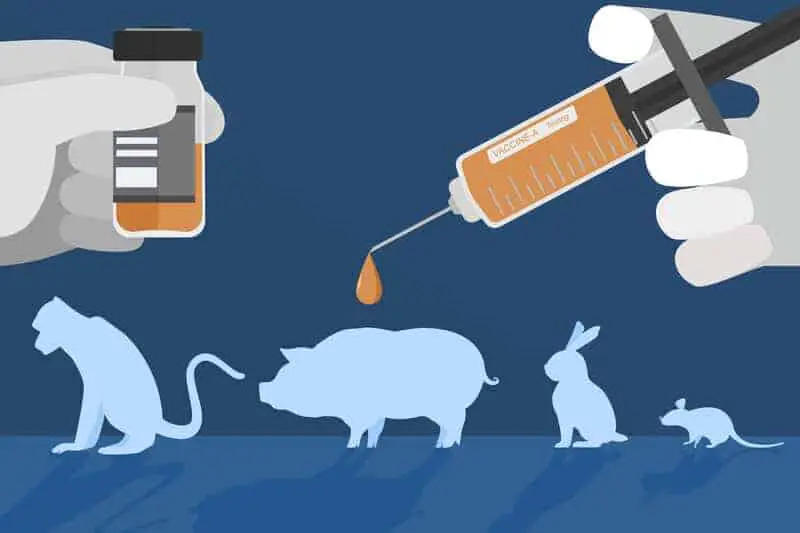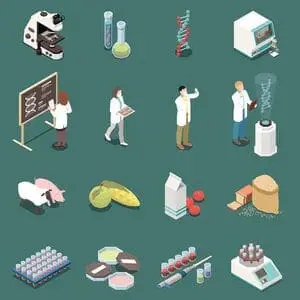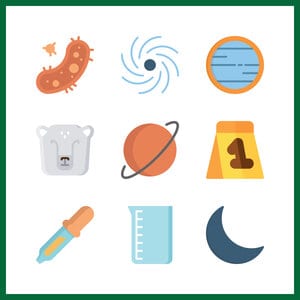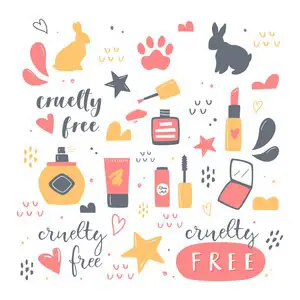- This post may contain affiliate links which - at no cost to you - may generate a small fee for us. It helps us research and review products more effectively
- A number of commercial products are tested on animals to ‘ensure product safety for customers’
- In some countries (China) testing on animals is required by law for certain products
- Alternatives to animal testing do exist (and are more effective) and we must work towards prioritising animal welfare
The marketing and sale of commercial products is –rightly – dictated by market regulations and laws. Many commercial products like cosmetics are tested on animals to determine their safety and efficacy to mankind.
And there are various animal welfare acts put in place to mitigate their unnecessary suffering. But unfortunately these acts:
- Only cover certain animals
- Don’t cover all testing facilities
- Have loopholes that smell suspiciously like they’ve been put in place to benefit large companies who stand to make a lot of money
But what’s new about that? Honestly in an era where you never have to leave your home to eat, work or exercise (very fortunate for 2020), it’s shameful more countries haven’t banned vanity product testing in particular.
And in cases such as the Animal Welfare Act of 2006, a researcher can bypass these protective jurisdictions if they believe it would negatively affect results. So in reality a number of these laws designed to protect animals are completely ineffective.

As the controversy surrounding animal testing shows no sign of abating – there absolutely are alternatives to animal testing – we have broken down animal testing laws from around the world.
Animal Testing Laws UK

The UK is one of the most advanced nations when it comes to protecting animal rights.
There have been general animal protection laws since 1822. The 1876 Cruelty to Animals Act granted additional protection to cats, dogs, monkeys and horses.
This 1876 law was greatly revised and became the Animals Scientific Procedures Act (ASPA) in 1986.
Firstly it’s illegal to use an animal if there is an alternative method available. And, were it to take place, the researcher must be able to prove that the expected benefits accrued from the research would outweigh the animal suffering.
“A ‘protected animal’ is any living vertebrate other than humans and any living cephalopod. They are not protected from being used in research, but they’re afforded legal protection under ASPA. A ‘regulated procedure’ is any test, experiment or other procedure done to a ‘protected animal’ which may cause them pain, suffering, distress or lasting harm.”
UK Government and Animal Testing
Three licences must be granted by the government before an experiment can take place:
- A personal licence for each person carrying out procedures on animals
- Project licence for the programme of work
- An establishment licence for the place at which the work is carried out
When applying for a project license, the researcher(s) must submit a harm-benefit analysis designed to weigh up the potential suffering the animal will go through vs the benefits of the experiment. Once this is complete the project must be approved by The Home Office, who carry out a similar harm-benefit analysis. Establishments typically review harm-benefit analyses internally at animal welfare and ethical review bodies (AWERBs) before their project licenses are sent to ASRU for approval. Unfortunately these discussions aren’t made public and it’s unclear how often AWERBs reject a project based on animal suffering. Things like this are particularly common with animal testing. Countries are unlikely to volunteer these largely damning statistics because of the negative PR attached to them – well done the UK in publishing annual animal testing reports.
0
Trained Inspectors responsible for all animal experiments across the UK
0
This equates to one inspector for every 154,545 animals used in research in the UK
Animal Testing in the USA

The US certainly doesn’t cover itself in glory when it comes to animal testing.
We believe the US could’ve performed the highest number of tests on animals in 2019. Probably only behind China.
The 1966 Animal Welfare Act (AWA) is the only federal law that regulates the treatment of animals. And whilst it applies to all research involving animals, it does not apply to all animals.
It’s limited to warm-blooded animals. And to be honest it doesn’t cover many of those. Since the inception of the 2002 Farm Security Act – an amendment to the AWA – specifically excluded purpose-bred (as opposed to wild-captured) birds, rats, and mice from regulation under the AWA.
As a result, the AWA now applies to relatively few animals commonly used in research. It even excludes mice, rats, and birds, which along with fish make up 95 % of the animals used in research.
That’s like claiming to be vegan by only giving up bacon. For such a culturally and economically dominant country, the scant regard for animal welfare is scandalous.
0
Trained USDA inspectors responsible for 12,000 facilities across the USA
Source: Animal Legal Defence Fund
0
This could equate to one inspector for every 191,667 animals used in research in the USA
Source: The broad ranging figure of 11 – 23 million is a best estimate for the number of animals used in US laboratories.
These are frightening – and disappointing – numbers.
How is it possible a country the magnitude of the USA puts such little resource behind animal welfare?
What makes this even worse is that the paltry number of inspectors also have to cover those involved in the of exhibition, breeding and dealing of animals, like zoos, commercial dog breeders and circuses.
Animal Testing in China
A trickier one to unpick because the only laws China has put in place are to require animal testing.
Prior to 2014, all cosmetics produced domestically or imported into China had to undergo animal testing. Since then, China has permitted the use of non-animal safety tests on some categories of cosmetics produced domestically.
Although it doesn’t sound like much, this was a monumental win for animal activists .
However, animal testing on products manufactured outside China remains mandatory. There’s a very confusing table that (sort of) explains China’s confusing, antiquated animal testing policies.
*Ordinary cosmetics include make-up, fragrances, skin, hair and nail care products
**Special use cosmetics include hair dyes, perms and hair growth products, deodorants, sunscreens, skin-whitening creams. Essentially ‘functional’ products
Animal testing in Hong Kong
While Hong Kong is technically a part of China, they don’t have the same testing laws as mainland China. Thank heaven for small mercies!
Confusing as it is, we know that mainland China currently requires animal testing on the large majority of cosmetic and beauty products. Whereas Hong Kong has been able to maintain their own laws about animal testing.
This means that brands can sell in Hong Kong and be cruelty-free. They recognise many of the international safety standards set under the Consumer Goods Safety Ordinance (Cap. 456), but don’t require additional animal testing to determine the safety and efficacy of products.
Animal Testing in Australia
On the 1st July 2020 Australia implemented a ban on cosmetic testing on animals.
This means any new cosmetic ingredients manufactured in, or imported into Australia will not be able to use information from animal testing to prove product safety and efficacy.
This is arguably as important as the original ban because:
- You can no longer sell products in Australia if the product safety has been determined through animal testing
- This applies to individual ingredients and fully-formed products
- So any brands relying on their animal testing safety credentials will have to go through a completely new process
And really these bans are bigger than the individual country.
It forces companies and countries to reconsider their current processes because there are serious financial implications. Australia’s a (sort of) huge market and joining the EU in banning cosmetic testing on animals is a step in the right direction.
A lovely glimmer of hope in an otherwise largely bleak 2020. Now we just need the USA to pull their head out of the sand and China to stop being the archaic behemoth that it is and we can move on.
How will Australia Enforce the Ban?
Glad you asked! Someone needs to be held accountable and really it’s twofold:
- The ever-so sexy Industrial Chemicals Act of 2019
- Designed to establish a national regulatory scheme for industrial chemicals
- Means that if an industrial chemical is to be introduced for an end use solely in cosmetics
- A person may not use animal test data obtained from tests conducted on or after 1st July 2020
- And the legitimately sexy Animal Ethics Code
- The National Health and Medical Research Council is working with state and territory governments
- To help them incorporate a testing ban through their legislation triggered by changes
We were hoping the test data would be backdated and brands wouldn’t be able to sell products or ingredients based on ANY animal testing data. Even pre-2020.
But we’ve still celebrated the ban of course. Cava rather than champagne though. Which, rather fortunately, is one of Adelle’s favourite drinks.
Animal Testing in India

India’s Prevention of Cruelty to Animals Act (1960) – their first animal welfare law – made cruelty to animals illegal. However, exceptions are made for the treatment of animals used for food and scientific experiments.
This law also gave birth to the Animal Welfare Board of India (1962). A society dedicated to the welfare of animals who, in a landmark 2014 case, fought and won for animals fundamental right to freedom.
The 2006 amendment to the 1998 Breeding and Experimentation on Animals Act, specified that animals lowest on the phylogenetic scale – or simpler lifeforms – must be used first.
A wholeheartedly sensible approach, unless of course you are an amoeba.
A final amendment to the law meant that experimenters must be able to justify not using animal testing alternatives and to only use the minimum number of animals to achieve 95% statistical confidence.
Global Animal Testing Laws – Summing Up
The UK – and the EU – have banned animal testing on cosmetics. As have India, Australia and a host of other nations.
Animal testing alternatives are becoming more commonplace and attitudes are changing. Animals are no longer the first port of call when it comes to testing globally. And that’s a wonderful thing to be a part of.
But we still have a long way to go:
- China still have archaic animal rules and regulations in place
- And many brands are sucked in by the Chinese market
- America has too many loopholes and performs too many tests behind closed doors
- And the majority of companies haven’t banned vanity product testing
But we’re moving in the right direction. Some countries (and companies) just need a kick up the arse.

